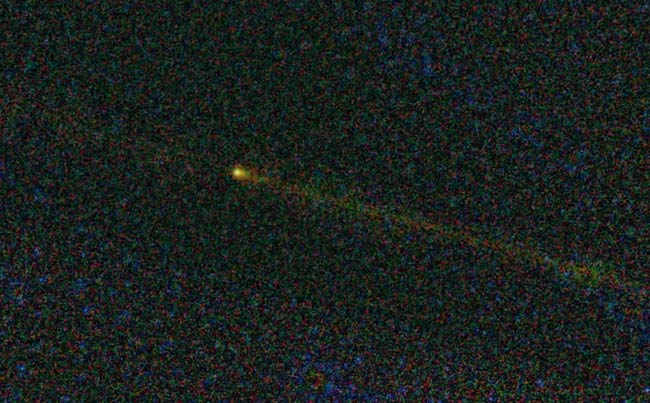New Comet Photos Show Icy Target for NASA Probe

New photosof an icy comet taken from Earth and space are giving astronomers a tantalizingpreview of the object ahead of an upcoming flyby of a NASA spacecraft.
In onephoto, the Comet Hartley 2 is shown as it appeared to the camera eye of NASA'sWide-field Infrared Survey Explorer ? or WISE ? a space telescope scanning thesolar system for hidden asteroids and comets. Another snapshot, taken by a NASAscientist using an Earth-based telescope, shows the comet as little more than abright green smudge against the black background of space. [New Photo of CometHartley 2]
Even theHubble Space Telescope has taken a gander at Hartley 2, revealing it as a bright comet sailing in a sea of night. The comet is nearly 1 mile (1.5 km)wide, according to the Hubble observations.
The newphotos set the stage for the planned Nov. 4 flyby of CometHartley 2 by NASA's Deep Impact spacecraft, a probe that completed its mainmission to a different comet in 2005 and is being recycled to visit Hartley 2as part of a new project called Epoxi.
"Wewant to know how the comet behaves as it comes toward the sun and out of deepfreeze," said James Bauer, a scientist at NASA's Jet Propulsion Laboratoryin Pasadena, Calif., working on the WISE mission. "The WISE image is onecritical puzzle piece of many that will give a comprehensive view of thebehavior of the comet through the time of the encounter." [WISE Telescope Imageof Comet Hartley 2]
NASAscientist William Cooke took the new ground-based photo of Comet Hartley 2.Cooke used a telescope near Mayhill, N.M, which he controlled via the Internetfrom his home in Huntsville, Ala.
"Comet-watchingfrom the comfort of your living room!" NASA officials wrote in a blog."Modern astronomy is truly amazing."
Get the Space.com Newsletter
Breaking space news, the latest updates on rocket launches, skywatching events and more!
Greencomet approaches Earth
CometHartley 2, also known as 103P/Hartley 2, is a small periodic comet. It wasfirst spotted by Australian astronomer Malcolm Hartley in 1986 and orbits thesun once every 6.5 years.
This year, thecomet will make its closest approach to Earth since it was first discovered. OnOct. 20 it will come within 11 million miles (17.7 million km) of Earth.
ThisSPACE.com CometHartley 2 skywatching guide describes how to see the celestial event.
Dustycomet in photos
The WISEphoto of Comet Hartley 2 was taken on May 10, but released today (Oct. 5). Thecomet has been displaying an increasing amount of activity in recent months,with gas and dust erupting from jets as it draws closer to the sun.
"Comparingthe dust early on to what we see later with Epoxi helps us understand how theactivity started on Hartley 2," said Epoxi mission principal investigatorMichael A'Hearn of at the University of Maryland in College Park.
But theobservations from Hubble found no evidence of the types of outgassing jetstypically seen in the so-called "Jupiter family" of comets, a groupthat includes Hartley 2. Instead, the comet appears to have a more uniformnucleus, suggesting that the material on its surface is relatively young, researcherssaid.
- Video Sky Map: How to Spot Comet Hartley 2
- Gallery: The Great Comet McNaught: Part 1, Part 2
- Comet and Earth to Have Rare Close Encounter
Join our Space Forums to keep talking space on the latest missions, night sky and more! And if you have a news tip, correction or comment, let us know at: community@space.com.

Tariq is the Editor-in-Chief of Space.com and joined the team in 2001, first as an intern and staff writer, and later as an editor. He covers human spaceflight, exploration and space science, as well as skywatching and entertainment. He became Space.com's Managing Editor in 2009 and Editor-in-Chief in 2019. Before joining Space.com, Tariq was a staff reporter for The Los Angeles Times covering education and city beats in La Habra, Fullerton and Huntington Beach. In October 2022, Tariq received the Harry Kolcum Award for excellence in space reporting from the National Space Club Florida Committee. He is also an Eagle Scout (yes, he has the Space Exploration merit badge) and went to Space Camp four times as a kid and a fifth time as an adult. He has journalism degrees from the University of Southern California and New York University. You can find Tariq at Space.com and as the co-host to the This Week In Space podcast with space historian Rod Pyle on the TWiT network. To see his latest project, you can follow Tariq on Twitter @tariqjmalik.









